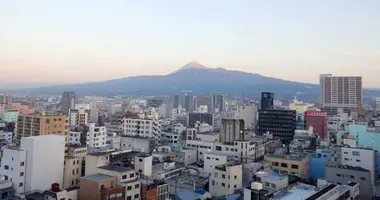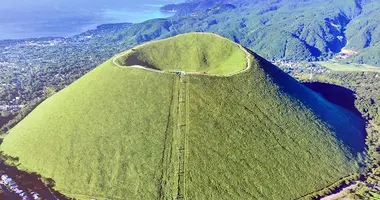Jogasaki Coast: A scenic coastal journey along the Izu Peninsula
- Published on : 23/06/2024
- by : Japan Experience
- Youtube

Jogasaki Coast, Izu Peninsula, Shizuoka Prefecture
The Jogasaki Coast, known as Jogasaki Kaigan in Japanese, is a rugged stretch of dark volcanic coastlinelocated on the eastern shore of the Izu Peninsula. Part of the Fuji-Hakone-Izu National Park, this stunning coastal area offers visitors a unique blend of natural beauty, geological wonders, and cultural significance. Stretching for about 9 kilometers, the Jogasaki Coast provides breathtaking views of jagged cliffs, volcanic rock formations, and the vast Pacific Ocean. Whether you're an avid hiker, nature enthusiast, or simply seeking a peaceful retreat, the Jogasaki Coast promises an unforgettable experience that showcases the raw beauty of Japan's coastline.
Overview of the Jogasaki Coast
The Jogasaki Coast is renowned for its dramatic landscape shaped by volcanic activity. Formed approximately 4,000 years ago by a massive eruption from nearby Mount Omuro, the coastline features a unique geological composition. The lava flow from this eruption created the distinctive cliffs and rock formations that define the area today. As part of the Izu Peninsula Geopark, the Jogasaki Coast offers visitors a fascinating glimpse into the region's volcanic history.
One of the most iconic features of the Jogasaki Coast is the Kadowaki Suspension Bridge. Spanning 23 meters in length and standing 48 meters above the water, this bridge provides spectacular views of the surrounding cliffs and ocean. Nearby, the Kadowaki Lighthouse offers panoramic vistas of the coastline and, on clear days, views of Izu Oshima Island.
The coast is not only a geological marvel but also a biodiversity hotspot. Its waters are home to a variety of marine life, including rare fish species and vibrant coral communities. The area's unique ecosystem makes it a popular destination for nature lovers and researchers alike.
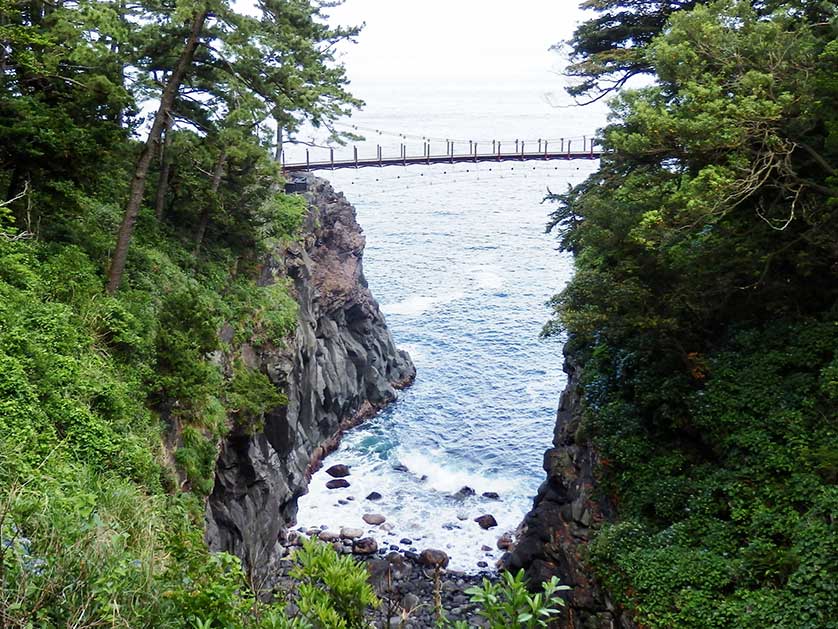
Kadowaki Suspension Bridge, Jogasaki Coast
Hiking trails and attractions
The Jogasaki Coast boasts several well-maintained hiking trails that allow visitors to explore its natural beauty up close. The main trail stretches for about 9 kilometers, offering various routes to suit different preferences and fitness levels:
- The Jogasaki Hiking Path: This trail offers two options - a shorter inland route through the woods and a longer coastal path that follows the cliff line, providing stunning ocean views.
- The Picnical Course: A popular and relatively easy trail that leads to the Kadowaki Lighthouse and Suspension Bridge.
- The Nature Study Course: This trail focuses on the area's flora, fauna, and geological features, with informative signboards along the way.
Along these trails, hikers can encounter several noteworthy attractions:
- The Kadowaki Lighthouse and Kadowaki Suspension Bridge: Offering panoramic views of the coastline and surrounding islands.
- Futo Harbor: A quaint fishing village with traditional "mullet watch houses".
- Renchaku-ji Temple: An ancient Buddhist temple located near the coastline.
- Tajima-no-taki Waterfall: A picturesque waterfall that cascades directly into the sea.
- Oyodo-Koyodo Tide Pools: Fascinating rock formations that create natural pools at low tide.
These attractions combine to create a diverse and engaging hiking experience, suitable for both casual walkers and more serious trekkers.
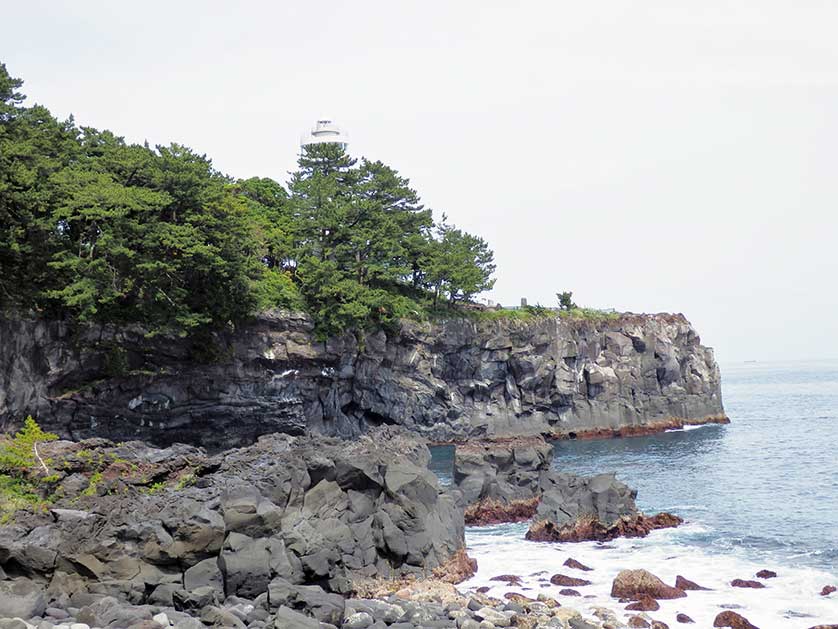
Jogasaki Coast with Kodawaki Lighthouse
Natural features and geological wonders
The Jogasaki Coast is a treasure trove of geological wonders, showcasing the raw power of volcanic activity. Some of the most notable features include:
- Columnar jointing: A fascinating geological phenomenon where cooling lava forms hexagonal columns of rock.
- Lava plugs: Also known as lava necks, these are unique formations created when lava hardens within a volcanic vent.
- Bizarre rock formations: The coastline is dotted with uniquely shaped rocks and cliffs, sculpted by lava flows and millions of years of erosion.
- Sea caves and inlets: The constant action of waves has carved out numerous caves and inlets along the coast, creating a dramatic landscape.
The Izu Peninsula Geopark, of which the Jogasaki Coast is a part, provides educational resources and guided tours to help visitors understand and appreciate these geological marvels. The park's mission is to promote conservation while educating the public about the area's unique geological history.
Another remarkable feature is the coast's clear waters, which offer excellent visibility for observing marine life. On calm days, visitors can peer into the depths and spot various fish species swimming among the rocks.
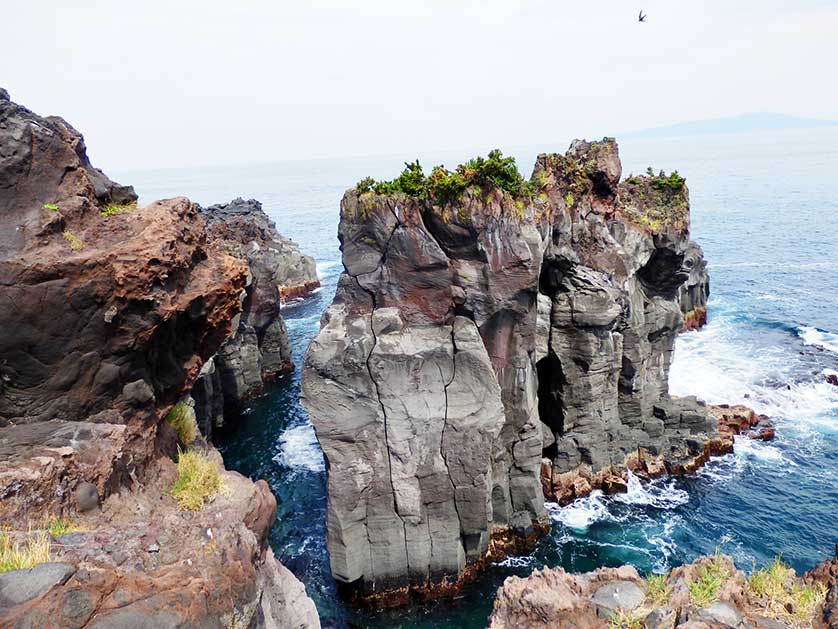
Rock formations on the Jogasaki Coast
Flora and fauna of the Jogasaki Coast
The Jogasaki Coast boasts a rich and diverse ecosystem, supporting a wide variety of plant and animal life. The area's unique blend of coastal and forest environments creates habitats for numerous species:
Flora:
- Japanese pines: These hardy trees thrive in the coastal environment, providing greenery year-round.
- Seasonal flowers: Depending on the time of year, visitors can enjoy cherry blossoms, hydrangeas, and wild peach trees.
- Coastal plants: Various species adapted to the harsh seaside conditions, including salt-tolerant grasses and shrubs.
Fauna:
- Marine life: The coastal waters are home to a variety of fish species, including rare gobies and other endemic species.
- Birds: Seabirds such as gulls and cormorants can often be spotted along the cliffs.
- Reptiles: The area is known for its population of Five-Lined Skinks, an introduced species that has become well-established.
- Mammals: While less common, visitors might occasionally spot smaller mammals like tanuki (Japanese raccoon dogs) in the forested areas.
The coast's biodiversity makes it an excellent destination for nature enthusiasts and wildlife photographers. However, visitors are reminded to respect the natural environment and observe wildlife from a safe distance.
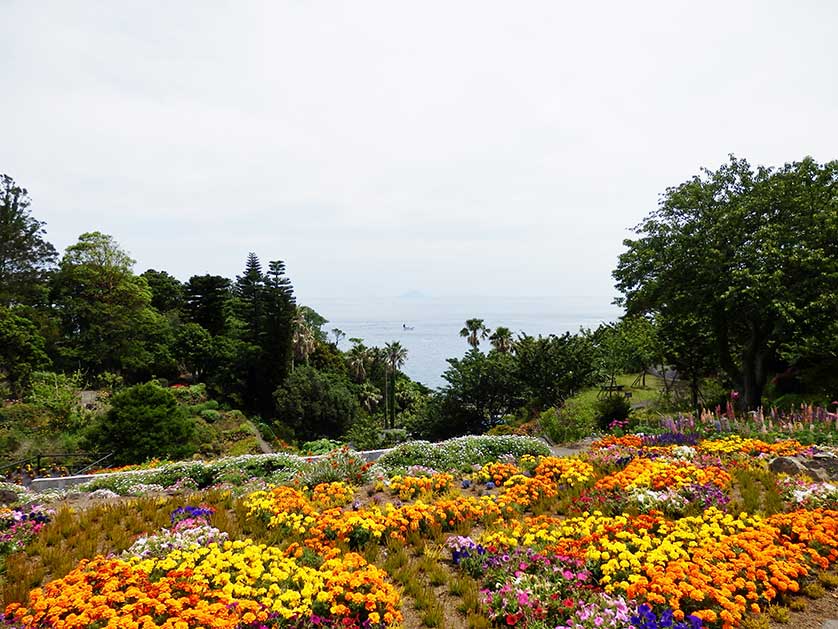
Izu Kaiyo Park, Jogasaki Coast
Practical information for visitors
To make the most of your visit to the Jogasaki Coast, consider the following practical information:
How to get to the Jogasaki Coast:
- Take the Tokaido Shinkansen to Atami Station, then transfer to the Izukyu Line.
- Get off at Jogasaki-Kaigan Station or Izu-Kogen Station, depending on which part of the coast you plan to visit.
- From the stations, you can either walk or take a bus to the trailheads.
Best times to visit:
- The coast is accessible year-round, but spring (March to May) and autumn (September to November) offer the most pleasant weather for hiking.
- Summer can be hot and humid, but the coastal breeze provides some relief.
- Winter offers clear views but can be chilly, so dress warmly.
Facilities:
- There are restrooms and vending machines available at the main entry points and some locations along the trails.
- The Izu Kaiyo Park / New York Lamp and Flower Museum offers dining options and a place to rest.
- The Boranaya Restaurant near the northern end of the coast serves traditional seafood dishes.
Safety tips:
- Wear appropriate footwear for hiking on potentially slippery surfaces.
- Stay on marked trails and be cautious near cliff edges.
- Check weather forecasts before your visit, as some areas may be dangerous during stormy conditions.
- Bring plenty of water, especially during summer months.

Oyster Bay stained glass window designed by Louis Comfort Tiffany at the New York Lamp and Flower Museum (Izu Kaiyo Park)
Best times to visit and seasonal highlights
The Jogasaki Coast offers unique experiences throughout the year, each season bringing its own charm:
Spring (March to May):
- Cherry blossoms bloom along parts of the trail, usually in late March to early April.
- Mild temperatures make for comfortable hiking conditions.
- Clear skies often provide excellent visibility for coastal views.
Summer (June to August):
- Hydrangeas bloom from May to July, adding splashes of color to the landscape.
- The coastal breeze offers relief from the summer heat.
- Ideal time for diving and water activities in the nearby areas.
Autumn (September to November):
- Comfortable temperatures return, making it an excellent time for hiking.
- Clear autumn skies offer stunning views of the coastline and distant islands.
- Fall colors can be seen in the forested areas near the coast.
Winter (December to February):
- The coast is less crowded, offering a more serene experience.
- Clear winter days provide crisp, far-reaching views.
- Possibility of seeing snow-capped Mount Fuji in the distance on very clear days.
Remember that regardless of the season, weather conditions can change quickly along the coast. Always check the forecast and come prepared with appropriate clothing and gear.
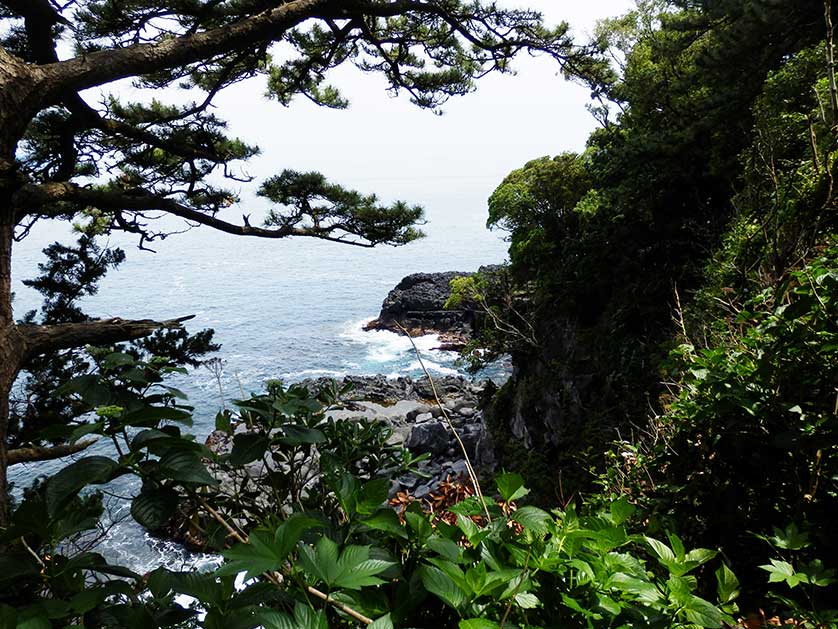
Peek towards the Jogasaki cliffs from the Jogasaki Coast hiking course
Cultural and historical significance of the area
The Jogasaki Coast holds significant cultural and historical value, reflecting Japan's rich maritime heritage and its relationship with the surrounding natural environment:
Historical significance:
- The area played a role in Japan's coastal defense during the late Edo period. A replica of a 19th-century cannon can be seen along the trail, reminding visitors of the coast's strategic importance.
- Traditional fishing practices, such as the use of "mullet watch houses" in Futo Harbor, showcase the long-standing relationship between local communities and the sea.
- The ancient Renchaku-ji Temple near the coast represents the area's Buddhist heritage.
Cultural importance:
- The Jogasaki Coast has inspired numerous artists and writers over the years, appearing in Japanese literature and traditional artwork.
- Local legends and folklore associated with the unique rock formations add a layer of mystique to the natural landscape.
- The coast is part of the larger Izu Peninsula, which has been a popular resort area since the Edo period, attracting visitors with its hot springs and scenic beauty.
Conservation efforts:
- The inclusion of the Jogasaki Coast in the Fuji-Hakone-Izu National Park and the Izu Peninsula Geopark highlights its importance in Japan's natural and geological heritage.
- Ongoing research and conservation efforts focus on protecting the area's unique ecosystem and geological features for future generations.
Visitors to the Jogasaki Coast can deepen their appreciation of the area by learning about its cultural significance and historical context. This understanding enhances the experience of the natural beauty and geological wonders that make the coast a truly remarkable destination.
For those interested in exploring more of the region, nearby attractions include the hot spring resorts of Ito City and Atami, as well as the historic port town of Shimoda. These destinations, along with the Jogasaki Coast, offer a comprehensive experience of the Izu Peninsula's natural beauty, history, and culture.
For more information on traveling in Japan, including detailed Japan City Guides and tips on transportation and accommodation, be sure to check out our comprehensive resources. Whether you're planning a day trip or a longer stay, the Jogasaki Coast and surrounding Izu Peninsula offer a wealth of experiences for every type of traveler.




